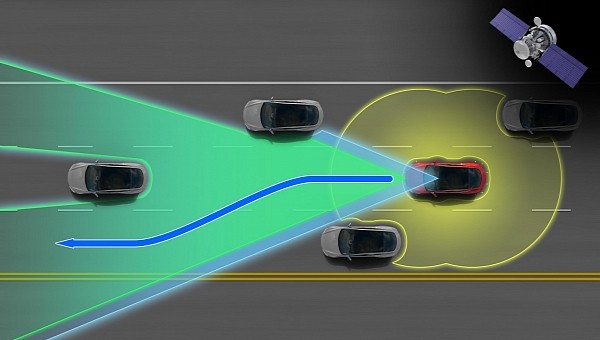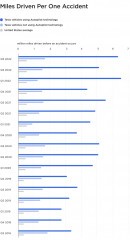Tesla quietly stopped publishing its quarterly Vehicle Safety Reports in 2022. Now, they are again on its website, including the missing reports from 2022. The company claims that it adjusted the metrics included in the calculations to better reflect reality. The result was that things look even better now, which might raise some eyebrows.
Tesla is continuously under fire for crashes allegedly produced while driving on Autopilot. Most recently, a phantom-braking problem on a Tesla Model S driving on an interstate caused a massive car pileup in San Francisco. Regulators are also keeping an eye on Tesla, which has a history of cutting corners when it comes to respecting regulations. All this time, Tesla insisted that its safety-assist features help avoid crashes and make driving safer. This was the whole point of releasing accident statistics.
Nevertheless, after releasing the Q4 2021 report, Tesla stopped updating its website without offering an explanation. The move ended a practice that endured for more than three years at the time the reports stopped. They consistently showed that driving on Autopilot is much safer than driving without. The fact that Tesla put them under wraps suddenly led many people to believe the EV maker had reason to act like that. More specifically, the stats were getting worse and showing this was not in Tesla’s interest.
To everyone’s surprise, the reports returned in January, and Tesla updated the corresponding page on its website to explain the major change it introduced to the way it reports Autopilot crashes. According to the January update, Tesla eliminated events where no airbag or active restraints were deployed, as well as those counted more than once and reports of invalid or duplicated mileage records. Tesla used the new metrics for the previously unreleased reports, but it also updated all collision rates historically to account for the changes.
Make no mistake, Tesla doesn’t explain why the company stopped reporting the vehicle safety stats, as some news outlets claim. For all we care, critics were probably right to assume the reports didn’t look good. Otherwise, Tesla wouldn’t have bothered modifying old files to reflect the changes. This assumption is further supported by the fact that the adjusted metrics make Tesla Autopilot’s old stats even more impressive than they already were.
For instance, Tesla originally reported one accident for every 4.19 million miles in Q1 2021 when Autopilot was active. With the new criteria in place, the report now claims one accident every 4.6 million miles. The new formula also shows that Tesla recorded one accident every 6.26 million miles in Q3 2022, the last quarter for which data exists. This compares favorably to one accident every 1.8 million miles when the Autopilot was not engaged and about 652,000 miles for all vehicles in the U.S.
Tesla still doesn’t offer any statistics about its Full Self-Driving Beta program, which might lead people to believe there’s nothing to brag about. Coincidentally, the increase in drivers enrolled in the FSD Beta program overlaps with the period Tesla stopped releasing Autopilot figures. We’d prefer the company to be more open about these stats, although we guess we’ll have to do with what we have for now.
Nevertheless, after releasing the Q4 2021 report, Tesla stopped updating its website without offering an explanation. The move ended a practice that endured for more than three years at the time the reports stopped. They consistently showed that driving on Autopilot is much safer than driving without. The fact that Tesla put them under wraps suddenly led many people to believe the EV maker had reason to act like that. More specifically, the stats were getting worse and showing this was not in Tesla’s interest.
To everyone’s surprise, the reports returned in January, and Tesla updated the corresponding page on its website to explain the major change it introduced to the way it reports Autopilot crashes. According to the January update, Tesla eliminated events where no airbag or active restraints were deployed, as well as those counted more than once and reports of invalid or duplicated mileage records. Tesla used the new metrics for the previously unreleased reports, but it also updated all collision rates historically to account for the changes.
Make no mistake, Tesla doesn’t explain why the company stopped reporting the vehicle safety stats, as some news outlets claim. For all we care, critics were probably right to assume the reports didn’t look good. Otherwise, Tesla wouldn’t have bothered modifying old files to reflect the changes. This assumption is further supported by the fact that the adjusted metrics make Tesla Autopilot’s old stats even more impressive than they already were.
For instance, Tesla originally reported one accident for every 4.19 million miles in Q1 2021 when Autopilot was active. With the new criteria in place, the report now claims one accident every 4.6 million miles. The new formula also shows that Tesla recorded one accident every 6.26 million miles in Q3 2022, the last quarter for which data exists. This compares favorably to one accident every 1.8 million miles when the Autopilot was not engaged and about 652,000 miles for all vehicles in the U.S.
Tesla still doesn’t offer any statistics about its Full Self-Driving Beta program, which might lead people to believe there’s nothing to brag about. Coincidentally, the increase in drivers enrolled in the FSD Beta program overlaps with the period Tesla stopped releasing Autopilot figures. We’d prefer the company to be more open about these stats, although we guess we’ll have to do with what we have for now.






